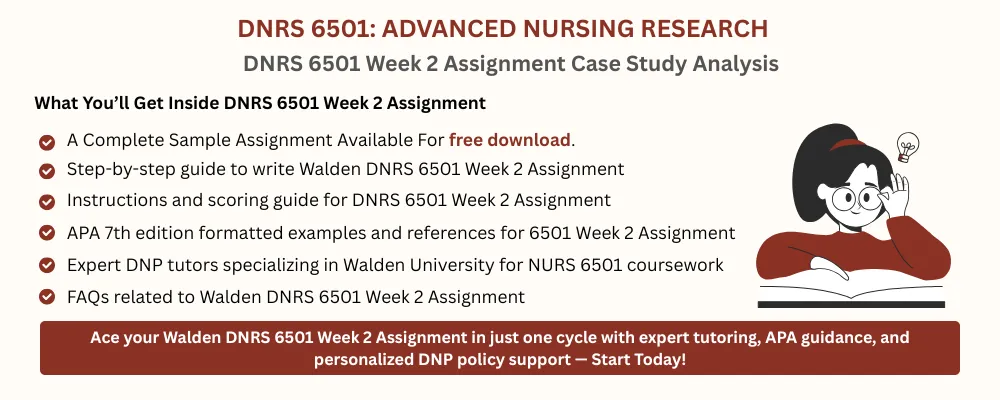DNRS 6501 Week 2 Assignment FREE DOWNLOAD
DNRS 6501 Week 2 Assignment
Case Study Analysis
Student Name
Walden University
DNRS 6501: Advanced Nursing Research
Professor Name
Date
Case Study Analysis
Amyotrophic Lateral Sclerosis (ALS) is a fatal neurodegenerative disease, where there is progressive degeneration of the motor neurons, with manifestations of paralysis of muscles, loss of respiratory capacity, and paralysis (Keon et al., 2021). Familial ALS was diagnosed in 32-year-old Maria Lopez via an SOD1 gene mutation in this case report. The report outlines pathophysiology at the cellular level, the presence of genetic mutation, its impact on the immune system, as well as on modalities of cure.
Pathophysiology and Symptom Development
ALS selectively kills motor neurons in the spinal cord and brain and results in progressive muscle weakness and atrophy. Upper and lower motor neuron degeneration results in faulty voluntary control of the muscles, producing symptoms of muscle fasciculations, spasticity, dysphagia, and respiratory failure (Pikatza-Menoio et al., 2021). Maria has classic ALS symptoms, including progressive muscle weakness (3/5 strength), dysarthria, absent gag reflex, and diaphragmatic weakness.
Her deteriorating respiratory function is underscored in arterial blood gas tests with low pH (7.30), high pCO2 (55 mmHg), and low pO2 (78 mmHg). The findings are indicative of hypoventilation secondary to diaphragmatic weakness that places her at high risk for respiratory failure. In addition, her high white blood cell level (12.3 × 10^9/L) and C-reactive protein (8.2 mg/L) reflect an inflammatory response secondary to aspiration pneumonia, a frequent complication in ALS patients with bulbar dysfunction (Pikatza-Menoio et al., 2021).
Genetic Mutations and ALS Pathogenesis
Maria’s inherited diagnosis of ALS results from a SOD1 gene mutation coding for superoxide dismutase 1. Superoxide dismutase 1 is an enzyme that aids in free radical removal. Mutations of SOD1 cause toxic protein clumping, oxidative stress, and apoptosis, leading to motor neuron death (Guo et al., 2024). Progressive motor neuron loss results in the disruption of neuromuscular transmission and causes muscle weakness, atrophy, and independent breathing loss. Her family history, including her mother’s death from ALS at the age of 50, also supports the hereditary aspect of the disease.
Impact on the Immune System and Treatment Strategy
Neuroinflammation plays a significant role in the progression of ALS. Activated microglia and astrocytes release pro-inflammatory cytokines, which enhance neuronal degeneration (Liu et al., 2021). Maria’s immune response, as reflected by increased inflammatory markers, suggests that immune dysregulation is involved in disease progression.
Treatment approaches now include slowing the progression of disease and symptom management. Riluzole 50 mg BID blocks glutamate excitotoxicity, extending survival. Baclofen to 10 mg TID reduces muscle spasticity. The use of Nuedexta, as directed, can reduce bulbar symptoms, enhancing speech and swallowing function (Liu et al., 2021). Non-invasive ventilation (BiPAP) is indicated to aid respiratory function, and PEG tube insertion is provided to avoid aspiration-related complications and ensure proper nutrition.
Conclusion
Maria Lopez’s condition reflects the intricate interplay of genetic, cellular, and immunological mechanisms that underlie ALS disease progression. Her worsening neuromuscular function requires multimodal therapy with respiratory care, nutritional support, and symptom control. Because no cure is available, interventions like BiPAP, PEG tube insertion, and adjustment of medications are utilized to improve her quality of life and delay disease progression.
Instructions To Write DNRS 6501 Week 2 Assignment
Need instructions for this assessment? Contact us now and get expert guidance right away!
Instructions File For 6501 Week 2 Assignment
CASE STUDY ANALYSIS
An understanding of cells and cell behavior is a critically important component of disease diagnosis and treatment. But some diseases can be complex in nature, with a variety of factors and circumstances impacting their emergence and severity.
Effective disease analysis often requires an understanding that goes beyond isolated cell behavior. Genes, the environments in which cell processes operate, the impact of patient characteristics, and racial and ethnic variables all can have an important impact.
An understanding of the signals and symptoms of alterations in cellular processes is a critical step in the diagnosis and treatment of many diseases. For APRNs, this understanding can also help educate patients and guide them through their treatment plans.
In this Assignment, you examine a case study and analyze the symptoms presented. In 1-2 pages, you will answer the questions provided following the case scenario. You must use current evidence-based resources to support your answers. Follow APA guidelines. Follow the grading rubric.
RESOURCES
Be sure to review the Learning Resources before completing this activity. Click the weekly resources link to access the resources.
WEEKLY RESOURCES
To prepare:
By Day 1 of this week, you will be assigned to a specific case study for this Case Study Assignment. Please see the “Announcements” section of the classroom for your assignment from your Instructor.
The Assignment
Develop a 1- to 2-page case study analysis by answering the questions provided following the case scenario.
BY DAY 7 OF WEEK 2
Submit your Case Study Analysis Assignment by Day 7 of Week 2.
Reminder: The College of Nursing requires that all papers submitted include a title page, introduction,
summary, and references. The sample paper provided at the Walden Writing Center provides an
example of those required elements (available at
https://academicguides.waldenu.edu/writingcenter/templates). All papers submitted must use this
SUBMISSION INFORMATION
Before submitting your final assignment, you can check your draft for authenticity. To check your draft, access the Turnitin Drafts from the Start Here area.
1. To submit your completed assignment, save your Assignment as
WK2Assgn2_LastName_Firstinitial
2. Then, click on Start Assignment near the top of the page.
3. Next, click on Upload File and select Submit Assignment for review
DNRS 6501 Week 2 Assignment Rubrics




References For DNRS 6501 Week 2 Assignment
Guo, Y., Guan, T., Yu, Q., Nitesh Sanghai, Shafiq, K., Li, M., Jiao, X., Donghui Na, Zhang, G., & Kong, J. (2024). ALS-linked SOD1 mutations impair mitochondrial-derived vesicle formation and accelerate aging. Redox Biology, 69, 102972–102972. https://doi.org/10.1016/j.redox.2023.102972
Keon, M., Musrie, B., Dinger, M., Brennan, S. E., Santos, J., & Saksena, N. K. (2021). Destination amyotrophic lateral sclerosis. Frontiers in Neurology, 12. https://doi.org/10.3389/fneur.2021.596006
Liu, E., Karpf, L., & Bohl, D. (2021). Neuroinflammation in amyotrophic lateral sclerosis and frontotemporal dementia and the interest of induced pluripotent stem cells to study immune cells interactions with neurons. Frontiers in Molecular Neuroscience, 14. https://doi.org/10.3389/fnmol.2021.767041
Pikatza-Menoio, O., Elicegui, A., Bengoetxea, X., Naldaiz-Gastesi, N., López de Munain, A., Gerenu, G., Gil-Bea, F. J., & Alonso-Martín, S. (2021). The skeletal muscle emerges as a new disease target in amyotrophic lateral sclerosis. Journal of Personalized Medicine, 11(7), 671. https://doi.org/10.3390/jpm11070671
Best Professors To Choose From For DNUR 6501 Class
- Dr. Christine Frazer
- Dr. Carolyn Sipes
- Dr. Linda Johanson
- Dr. Catherine Fant
- Dr. Deborah Terry
(FAQs) related to DNRS 6501 Week 2 Assignment
Question 1: Where can I download a free sample for DNRS 6501 Week 2 Assignment?
Answer 1: Download it from Tutors Academy.
Question 2: Where can I find the rubrics and instruction file for DNRS 6501 Week 2 Assignment?
Answer 2: Available at Tutors Academy.
Question 3: What is DNRS 6501 Week 2 Assignment about?
Answer 3: A case study analysis of ALS, including pathophysiology, genetics, immune impact, and treatments.
Do you need a tutor to help with this paper for you with in 24 hours.
- 0% Plagiarised
- 0% AI
- Distinguish grades guarantee
- 24 hour delivery

